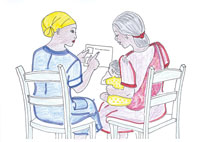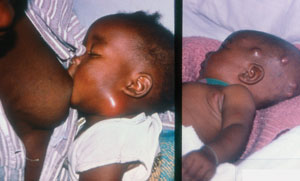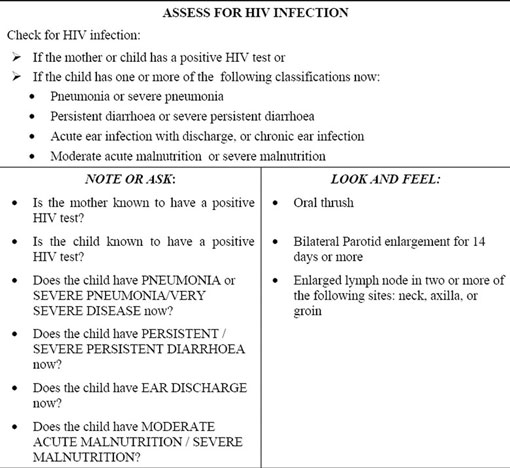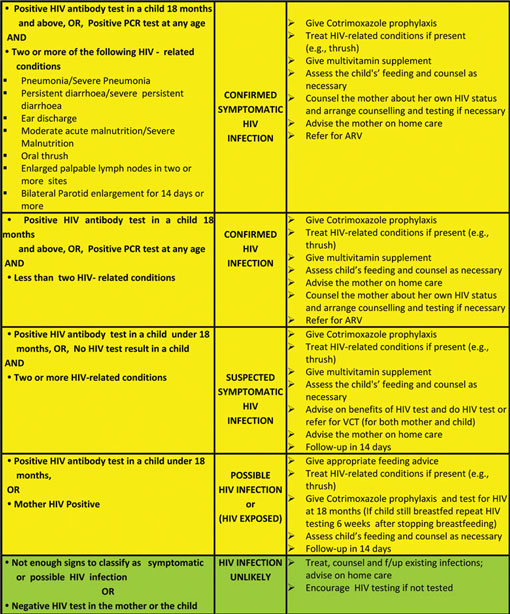Use 'Print preview' to check the number of pages and printer settings.
Print functionality varies between browsers.
Printable page generated Thursday, 25 April 2024, 6:11 PM
Integrated Management of Newborn and Childhood Illness Module: 9. Assessment of HIV Infection in Infants and Children
Study Session 9. Assessment of HIV Infection in Infants and Children
Introduction
Ethiopia is one of the Sub-Saharan African countries that is hit hard by the HIV/AIDS pandemic. Estimated HIV prevalence in the adult population is 2.4% (more than one million adults are living with HIV/AIDS). Currently an estimated 79,000 children under 14 years are living with HIV/AIDS. It is expected that more than 26,000 children require antiretroviral therapy (ART), but at the beginning of April 2009 only 10,077 children were receiving it. Without treatment 75% of all HIV-infected children will die before their fifth year.
The main way that children get HIV is from their HIV-infected mother. Not all HIV-infected mothers transmit the virus to their children. If 20 HIV-infected mothers give birth, only seven children will be HIV-infected (35%).
Children who are HIV-infected will have repeated other infections. Commonly occurring infections include pneumonia, persistent diarrhoea, ear discharge and oral thrush. The other common condition in HIV-infected children is malnutrition. You will learn about all of these in this study session.
Early identification of HIV infection in infants and children with ongoing follow-up and care can therefore help improve the quality of life of children who are HIV-infected. As a Health Extension Practitioner you have an important role in the identification and treatment of these children.
In this study session, you will learn how to assess and classify a child with possible HIV infection. The knowledge will help you to provide initial treatment, advice and referral of HIV cases.
Learning Outcomes for Study Session 9
When you have studied this session, you should be able to:
9.1 Define and use correctly all of the key words printed in bold. (SAQs 9.1 and 9.2)
9.2 Assess and classify infants and children for confirmed, suspected and possible HIV infection. (SAQs 9.1 and 9.2)
9.3 Provide the necessary initial treatment, advice and referral of HIV cases according to IMNCI guidelines. (SAQs 9.1 and 9.3)
9.4 Counsel the mother about HIV testing. (SAQ 9.3)
9.1 Assess for HIV infection

An important aspect of supporting a mother with a child who has HIV is to develop a good professional relationship with her so that she is able to trust you and give you the information you need to provide the best possible services for her and her child. If you ask questions in a thoughtless or judgmental way, the mother may be reluctant to give you the information that you need. Good communication skills will help you to establish a rapport with the mother and help her to understand how to look after the sick child.
You should also reassure the mother that as far as possible, what you discuss will remain confidential. You will learn more about good counselling skills in Study Session 14 of this Module.
When you assess a child for HIV infection, first you should ask about the HIV status of the mother and the HIV status of the child. Then you should note if the child has the following conditions:
- Pneumonia or severe pneumonia now
- Persistent or severe persistent diarrhoea now
- Acute ear infection with ear discharge or chronic ear infection
- Moderate acute malnutrition or severe malnutrition.
If the mother or child is known to be HIV-positive, or if the child has one or more of the above conditions, you should assess the child for HIV infection.
Box 9.1 below reproduces the relevant section from the Assess and Classify chart which tells you how to assess a child for HIV infection.
Box 9.1 Assess for HIV infection
You are now going to look at how to test for and interpret HIV test results.
9.2 Testing infants and children for HIV
The presence of HIV infection in a child can be detected by doing tests. Different tests are available to diagnose HIV infection; the first one is serological and the other is virological.
9.2.1 Positive HIV test
The method for the HIV rapid test is described in Study Session 24 of Communicable Diseases, Part 3. Study Session 28 of that Module deals with HIV in children.
Serological (or antibody) tests (also called rapid tests) detect antibodies made by immune cells in response to the virus. They do not detect the virus itself. An HIV-infected mother produces antibodies in her blood. These antibodies from the mother can get into the baby during delivery and may stay in the child’s blood until the age of 18 months. This means that a positive antibody test in children under the age of 18 months is not reliable and does not confirm that the child is truly HIV-infected. Serological or antibody tests are used to confirm HIV infection in children who are more than 18 months of age. If a rapid antibody test is done for a child older than 18 months and the result is positive, then that child is HIV-infected.
Virological tests, such as DNA PCR tests, directly detect HIV in the blood. These tests can therefore detect HIV infection in the child before the child is 18 months old. If a DNA PCR test is done for an infant and the result is positive, then that infant is HIV-infected.
You may get a child whose initial HIV test is negative, but if you know the mother is HIV-positive and is continuing to breastfeed, you should repeat the test because HIV can be transmitted in breastmilk. The test should be repeated six weeks after breastfeeding has stopped.
As you read above, when you ask a mother about her or her child’s HIV status, it is important that you pose the question in a careful way and maintain confidentiality as much as possible since this is sensitive information.
A two-month-old baby has a positive virological test. Is the baby HIV-infected?
Yes, because virological tests detect HIV in the blood and a positive test shows the presence of HIV, whatever the age of the baby and whether or not the baby is exclusively breastfed.
A two-month-old breastfeeding baby has a positive antibody (serological) test. Is the baby HIV-infected?
It is difficult to conclude in this case because, at two months, an antibody test cannot be used to confirm HIV infection. Antibodies can pass from mother to baby and may stay in the baby’s blood for as long as 18 months.
A 20-month-old child who has stopped breastfeeding more than six weeks ago has a positive HIV antibody test. Is that child HIV-infected?
Yes, because in a child who is 18 months or older, an antibody test can confirm the diagnosis of HIV infection.
A nine-month-old breastfeeding baby has a negative virological test. Is the baby HIV-infected?
It is difficult to conclude in this case. Although the test suggests now that the baby is not infected, if he is breastfeeding from an HIV-infected mother, he may acquire the infection later. Once a child is 18 months or older, the antibody test can be repeated six weeks after stopping breastfeeding.
9.3 Commonly occurring infections in HIV-infected children
In this section you will learn about some of the commonly occurring illnesses in HIV-infected children. You have already read about some of these infections in earlier study sessions in this Module. However, as we said above, infants and children with HIV are more likely to get these infections and get them more frequently. Therefore it is important for you to look at these infections again in the context of providing care for an infant or child with HIV.
9.3.1 Pneumonia
Pneumonia is the leading cause of hospital admissions and death in HIV-infected children and it presents in the same way in both infected and uninfected children. The difference is that bacterial pneumonia occurs repeatedly in children with HIV infection.
Prophylaxis refers to any treatment given to prevent a disease from developing.
Pneumocystis pneumonia (PCP) is another cause of pneumonia in HIV-infected children that you need to know about. It occurs most commonly during the first year of life. PCP is one of the major causes of severe pneumonia and death in HIV-infected infants. To protect HIV-infected infants and children from developing PCP and other infections you should give cotrimoxazole. All HIV-exposed infants (infants born from HIV-infected mothers) should also receive cotrimoxazole prophylaxis against PCP from six weeks of age until it is established that the child is not HIV-infected.
9.3.2 Persistent diarrhoea
This occurs with more frequency in HIV-infected children, and HIV-infected children with persistent diarrhoea are at higher risk of death compared with HIV-negative children with persistent diarrhoea. A child is said to have persistent diarrhoea if the diarrhoea lasts for 14 days or more.
9.3.3 Ear discharge
Acute and chronic ear infections are common in children with symptomatic HIV infection (i.e. symptoms of HIV disease are present); however, the management is the same as that of HIV-negative children.
9.3.4 Malnutrition
Symptomatic HIV infection is more frequently associated with moderate or severe degree of acute malnutrition. Micronutrient deficiencies are also common in children with HIV infection.
9.3.5 Oral thrush
Oral thrush is a thick white coating of the tongue and inside of the cheek. Unlike milk curds, it is difficult to remove and if removed it leaves small bleeding areas. It is the most common oral condition seen in HIV-infected children. Oral thrush is associated with difficulty or pain in swallowing or vomiting. It is caused by a fungus called Candida.
9.3.6 Parotoid enlargement
Bilateral parotid enlargements are swellings in front of both ears which do not cause pain and fever and last for more than 14 days. If you see bilateral parotid enlargement in a child, then the child is likely to be HIV-infected.
9.3.7 Lymph node enlargement
You should try to palpate for lymph nodes around the neck, in the axilla and groin. If you palpate lymph nodes and the size is greater than 1 cm then the lymph nodes are enlarged. Persistent generalised lymphadenopathy is defined as the development of enlarged lymph nodes in two or more of the following sites: neck, axilla and groin (see the photo of children with enlarged lymphnodes in Figure 9.2 below). Generalised lymphadenopathy is one of the most common early clinical presentations of HIV-infected children.

Once you have completed your assessment of the child, the next thing you have to do is to classify the child based on your assessment findings.
9.4 Classify for HIV infection
There are five classifications in the Assess and Classify chart. The relevant section of the chart is reproduced in Table 9.1 below.
Table 9.1 Classifying an infant or child for HIV infection.
You are now going to look in more detail at the basic differences between the different classifications set out in Table 9.1 above.
9.4.1 Confirmed symptomatic HIV infection
If a serological test for HIV in a child older than 18 months, or a DNA PCR test at any age, is positive and if you find two or more HIV-related conditions, you should classify the child as confirmed symptomatic HIV infection.
9.4.2 Confirmed HIV infection
If a child older than 18 months has a positive HIV serology, or a child at any age has a positive DNA PCR test, even if they have fewer than two HIV-related conditions, you should classify the child as confirmed HIV infection.
9.4.3 Suspected symptomatic HIV infection
A child with any two or more of the HIV-related conditions who either has no test result or, if under 18 months of age, has a positive serology test, the child should be classified as suspected symptomatic HIV infection.
9.4.4 Possible HIV infection
This classification is made when there are not enough signs to classify as confirmed/suspected symptomatic HIV infection. Possible HIV infections indicates HIV exposure evidenced by a positive HIV antibody test either in a child younger than 18 months old or in the mother.
9.4.5 HIV infection unlikely
When there are not enough signs and the HIV test of both the mother and the child are either not known or negative, you should classify the child as HIV infection unlikely.
9.5 Treating the child with HIV infection
A child classified as having confirmed symptomatic HIV infection, confirmed HIV infection or suspected symptomatic HIV infection, should receive cotrimoxazole prophylaxis treatment. You should also provide a multivitamin supplement, and refer the child for antiretroviral therapy (ART). In the case of a child with suspected symptomatic HIV infection, you should do an HIV test or refer. The child’s feeding should be assessed and you should advise the mother as necessary about the best feeding plan for her child. You should also advise the mother on home care and tell her to return for a follow-up visit in two weeks.
9.5.1 Give cotrimoxazole prophylaxis
The child who is known or suspected to be HIV-infected should be started on long term prophylaxis with cotrimoxazole. Regular prophylaxis with cotrimoxazole given to infants born to HIV-positive women and confirmed or symptomatic HIV infection is likely to decrease sickness and death due to PCP and other common bacterial infections. Cotrimoxazole for prophylaxis purposes is given once daily (you should refer to your chart booklet, page 31, for information about the correct dose when used for prophylaxis).
9.5.2 Initiation of prophylaxis
PCP prophylaxis should be given from six weeks of age to children in the following categories:
- an HIV-exposed child
- a child with confirmed HIV infection
- a child with suspected symptomatic HIV infection.
9.5.3 Cessation of prophylaxis
You should continue cotrimoxazole prophylaxis as long as the HIV-infected child is alive. You can discontinue cotrimoxazole in the following conditions:
- Once HIV infection has been ruled out by serology at or after 18 months of age.
- If the child develops skin lesions all over their body or has severe palmar pallor, you should stop cotrimoxazole and refer the child urgently.
9.6 Counsel the mother about HIV testing
The mother of a child classified as suspected symptomatic HIV infection, or possible HIV infection/HIV-exposed, will need to be counselled about both her and her child’s HIV testing. This is likely to be a sensitive subject. Many mothers, and even health workers, might have difficulty discussing HIV. However, HIV is present in the community and the problem will not be solved as long as there is secrecy. You should to discuss HIV issues openly, ask the mother questions, and give appropriate advice about herself and her child.
When you have identified a young infant or child who is in need of HIV testing you should provide the mother with information. Tell the mother that the condition of the child makes you think that HIV may be the cause of the illness. Explain that if the child has often been ill, this can be a sign of HIV infection. You should help the mother to understand that the reason for HIV testing is so that the child can receive treatment that will improve their quality of life. It is important that the child is given antibiotics to prevent infections, vitamin supplementation, regular growth monitoring, prompt treatment of any illnesses and antiretroviral therapy if it is needed. Interventions can also prevent other members of the family from becoming infected.
When you have explained all of this in a clear and sensitive way, you should give the mother time to ask questions. When she has agreed to the test, you should arrange for her to receive proper voluntary counselling and testing (VCT) in the normal way at your clinic.
9.7 Counselling the mother of a child with confirmed/suspected symptomatic HIV infection
You should begin by reassuring the mother that with the help of the health post staff and others, much can be done to improve and maintain her child’s health. You should:
- Advise the mother about future pregnancies, safe sex and early treatment of sexually transmitted diseases.
- Encourage the mother to seek voluntary counselling and testing.
- Ensure good nutrition; counsel the mother on feeding practices. Explain that she should breastfeed her child for the first six months and avoid introducing other foods (mixed feeding) during these six months.
- Explain the importance of early treatment of infections.
- Emphasise personal hygiene and the importance of hand washing.
- With the mother’s consent, refer her to the community health worker and/or a local support group.
Summary of Study Session 9
In Study Session 9, you have learned that:
- There are key questions to ask and signs to look for in the assessment of a child for HIV infection.
- Children with HIV infection are more likely to suffer from common childhood diseases.
- There are five HIV classifications for children:
- Confirmed symptomatic HIV infection
- Confirmed HIV infection
- Suspected symptomatic HIV infection
- Possible HIV infection or HIV exposed
- HIV infection unlikely.
- Initial treatment in children with HIV infection includes cotrimoxazole prophylaxis and treatment for oral thrush.
- It is important to keep confidentiality and maintain trust of the mother when counselling her about HIV testing.
Self-Assessment Questions (SAQs) for Study Session 9
Now that you have completed this study session, you can assess how well you have achieved its Learning Outcomes by answering these questions. Write your answers in your Study Diary and discuss them with your Tutor at the next Study Support Meeting. You can check your answers with the Notes on the Self-Assessment Questions at the end of this Module.
Read Case Study 9.1 and answer the questions below.
Case Study 9.1 for SAQ 9.1
Gizaw is 18 months old. He weighs 7 kg. His temperature is 37°C. His mother brought him today because the child has had diarrhoea for three days. There is no blood in the stool. You checked for general danger signs and there was no general danger sign detected.
He does not have a cough or difficulty breathing. You assessed him for diarrhoea and classified him as diarrhoea, no dehydration. He has no fever. He does not have ear problems.
You next checked him for malnutrition or anaemia. Gizaw does not have visible severe wasting. There is no palmar pallor. He does not have oedema of both feet. You measured MUAC and it is 11.7 cm.
Then you assessed Gizaw for symptomatic HIV infection. He has oral thrush. His parotid glands are enlarged. He has no enlarged lymph nodes. He tested HIV-positive using the antibody test.
SAQ 9.1 (tests Learning Outcomes 9.1, 9.2 and 9.3)
- a.What are Gizaw’s signs?
- b.How would you classify Gizaw for HIV infection and why?
- c.What treatment would you propose for Gizaw?
Answer
- a.Gizaw has moderate acute malnutrition with diarrhoea; he has oral thrush and enlarged parotid glands.
- b.The classification is confirmed symptomatic HIV infection.
- c.He should be treated with cotrimoxazole propylaxis, and a multivitamin and be referred for antiretroviral therapy.
Read Case Study 9.2 and then answer the questions below.
Case Study 9.2 for SAQ 9.2
Rediet is six months old. She weighs 7 kg. Her temperature is 36.8°C. Her mother brought her today because the child has been coughing for four days.
You checked for general danger signs and she does not have any of the general danger signs.
You assessed her for cough or difficult breathing. You counted 54 breaths per minute. Rediet has no chest wall in-drawing or stridor when calm. You classified Rediet as having pneumonia.
She does not have diarrhoea, fever or ear problems.
You next checked her for malnutrition or anaemia. Rediet does not have visible severe wasting. There is no palmar pallor. She does not have oedema of both feet. You measured MUAC and it is 11.5 cm.
Rediet’s mother had a positive HIV test done during her pregnancy. Rediet has oral thrush. She has no enlarged lymph nodes. Her parotid glands are not enlarged.
SAQ 9.2 (tests Learning Outcomes 9.1 and .2)
- a.How would you record Rediet’s signs?
- b.How would you classify Rediet for HIV infection?
- c.How would you counsel Rediet’s mother?
Answer
- a.Rediet has pneumonia and oral thrush. Her mother has a positive HIV test.
- b.The classification is suspected symptomatic HIV infection.
- c.The mother needs to be advised that the treatment will help her to look after Rediet.
SAQ 9.3 (test Learning Outcomes 9.3 and 9.4)
Why are good communication and counselling skills particularly important when you are advising the mother of a child with possible HIV infection?
Answer
HIV is a sensitive subject and there can be secrecy about it in a community. So the mother might be reluctant to tell you her own HIV status if she knows it and also be very concerned about confidentiality. But you need the help of the mother in different ways: testing for herself, looking after the child and also preventing the rest of the family being infected. So you need to work hard to gain her trust.

